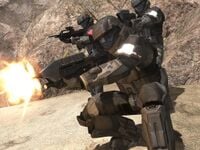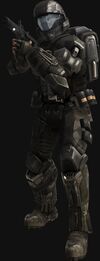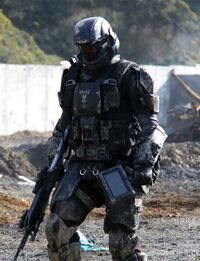ODST armor: Difference between revisions
From Halopedia, the Halo wiki
| Line 27: | Line 27: | ||
===Disadvantages=== | ===Disadvantages=== | ||
Unfortunately, the suit's general complexity leads to complications. Over prolonged periods of time the suit will become very uncomfortable to wear, and it is tricky to repair on the field. Its effectiveness is decreased in desert or arctic environments where harsh light and sparsity of dark colors make its grey and black camouflage BDUs/armor useless. It is more suited for night time, urban, and forest operations, which fortunately the ODSTs have seen plenty of | Unfortunately, the suit's general complexity leads to complications. Over prolonged periods of time the suit will become very uncomfortable to wear, and it is tricky to repair on the field. Its effectiveness is decreased in desert or arctic environments where harsh light and sparsity of dark colors make its grey and black camouflage BDUs/armor useless. It is more suited for night time, urban, and forest operations, which fortunately the ODSTs have seen plenty of. | ||
==MJOLNIR ODST Helmet== | ==MJOLNIR ODST Helmet== | ||
Revision as of 10:50, February 12, 2009

The Body Suit is the fully-sealed combat armor worn exclusively by the Orbital Drop Shock Troopers (ODST), special-operators of the UNSC Marine Corps.
Description
The helmet of the suit has a dark protective plate with matte black titanium armor surrounding it. The suit itself is black around the torso with a black and grey camouflage pattern around the legs. The boots and gloves are also black. There are often ad hoc additions on the shoulder plates, such as various colour flashes or the blood type of the ODST in question. There are also several variations to the ODST armor including Ranged, Close Quarters, and Recon; each designed for different missions.
History
Not much is known about the history, development, or implementation of the Body Suit. It is known that the SPARTAN-IIs used the Body Suit before they got their MJOLNIR Armour. The ODST Armor has come in several designs since its first iteration. The current armor is an offshoot of the MJOLNIR Armor, using CTC's and HUD Communications Systems from the MJOLNIR program to give more situational awareness to the wearer. The suit was recently upgraded with added protection, endurance, and agility.
It was then used on Delta Halo, during the events of Halo 2. It proved effective on the most part, absorbing the shock for most of the ODSTs inside the HEVs. Others; however, died on impact upon hitting the Halo's surface, though this was mainly from drowning after crashing in a lake or hitting a vertical surface, like the wall of a canyon. The suits could take a bit more damage than a normal, standard issue Marine combat ensemble, and much more than the ODST ballistic armor used on Alpha Halo.
By the events of Halo 3, however, the body suit became much more powerful, suggesting that in between Halo 2 and Halo 3, the technology was enhanced sufficiently, or that the ODSTs have switched their armor to a more reliable suit. The ODSTs using this armor helped The Master Chief, Thel 'Vadam, and the rest of the Separatist-UNSC forces to rout Covenant ground forces on the Ark. With the mentioning of a technological advance one should remember, when having read the book, Ghosts of Onyx that the SPARTAN, Kelly-087 sees the SPI Armour, and remarks on having to remember seeing ODSTs experimenting with a type of Camouflage armor that the SPARTAN-III generation wears.
Systems
The Body Suit has cooling and heating units that masks the infrared signature of the wearer, as well as creating a comfortable environment. The body armour, boots and gloves are fully encased and airtight, making them operable in a vacuum for up to fifteen minutes when equipped with an additional oxygen tank. The helmet has encrypted communications gear and a HUD, along with thermal and motion detectors giving the user an advantage over the standard Marines.
Advantages
The Body Suit is lightweight and offers protection in hard vacuum. It supplies more armour protection than standard Marine armour, and contains an enhanced communications suite. Along with the protection and communications gear, the Body Suit provides increased agility and maneuverability not afforded by standard Marine Armour. The Body Suit's helmet can withstand several headshots from head shot capable weapons. The armour’s black coloring gives wearers an advantage at night and in space, as well as providing a psychological advantage over foes.
Disadvantages
Unfortunately, the suit's general complexity leads to complications. Over prolonged periods of time the suit will become very uncomfortable to wear, and it is tricky to repair on the field. Its effectiveness is decreased in desert or arctic environments where harsh light and sparsity of dark colors make its grey and black camouflage BDUs/armor useless. It is more suited for night time, urban, and forest operations, which fortunately the ODSTs have seen plenty of.
MJOLNIR ODST Helmet
The MJOLNIR ODST helmet in Halo 3 is derived from the technology utilized in MJOLNIR armour. It is attained and unlocked by the Spartan Graduate Achievement, or getting 5 XP in Matchmaking. At one point in development the ODST helmet had an antenna on its back (See "Halo 3: PAX 2007 Omegathon Round 2 Cam Gameplay"; the antenna can be glimpsed for a brief moment when the player dies). The visor on the regular ODST helmets is blue, while the Spartan MJOLNIR ODST helmet has a dark orange visor.
- It is a theory that some MJOLNIR Variants may be used by Special ODST Units. One such theory indicates that the Scout Variant could be used by ODSTs.


